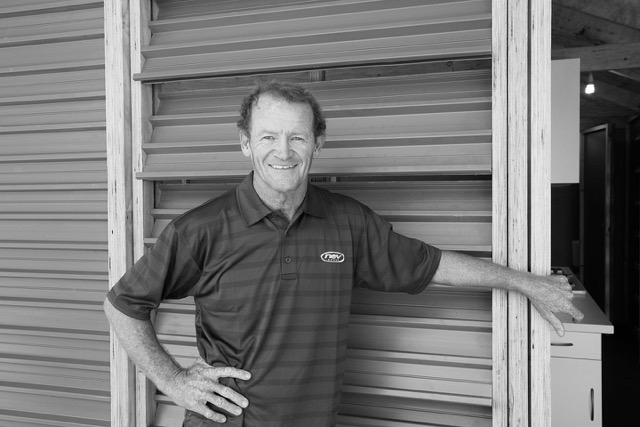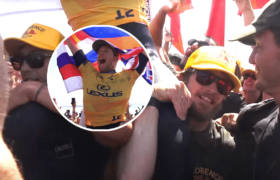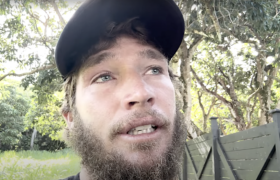Firewire founder Nev Hyman and the joy of Kelly Slater taking the wheel of his biz…
The Firewire founder Nev Hyman knew he’d done it, knew he’d created the game changer he’d been working on for 30 years when he was on a layover at Helsinki airport, Finland.
On an email, the Tahitian surfer Michel Bourez had written that he needed new boards for Teahupoo. Adjust this, change that etc.
Nev, who let’s be honest, was until that point happy swallowing the flaxen-haired gals loping by in their torn denim and bustiers with as much gusto as he was his inhaling his little espressos. What man with blood still in his veins doesn’t? But Nev opened up his AKU Shaper software, made the adjustments and emailed ’em to the Firewire factory in Thailand.
Nev knew they’d be finished, packed, and then sent to Tahiti where, four weeks later, Michel would open up the giant box and see his new improvised sleds.
Nev closed his computer and thought, “I’ve done it. Boards, one hundred per cent finished, without me touching ’em.”
*****
You ever hear of Nev Hyman? Maybe not. Short memories. Before I swing into the biz of Kelly Slater and his “70 per cent-plus” stake in Firewire, which is now official and there’ll be a press release from Firewire shortly, let’s talk a little about Nev. It’s worth the circumvent, it’ll give you a handle on the brand, so hang in there.
Nev is a 57-year-old surfboard shaper from Perth in Western Australia. When he was 20 he shifted to the Gold Coast and, soon, became one of its most popular shapers. Nev Surfboards – who thought that name could fly?

But Nev was always a smart cat. In the late eighties he was the guy who threw it on the line to not only champion machines that could shape boards from a computer program, but poured money into it. His dream was to shape a board on his laptop, send the details to a machine, and have it finish the board 100 per cent. Ready to ride.
The APS3000 and AKU Shaper machines and Shape 3-D software exist because of Nev. Because he believed in the technology even when it was deeply unpopular to do so. Because as much as he loved shaping, as much as he got off on those lucrative 15-board-a-day runs in Japan where he’d shape so much his fingers would bleed, he wanted to design. He wanted to watch a guy at Pipe, adjust his shape accordingly and, a few hours later, the new improved board would be on the sand ready to ride.
Nev shaped boards for every great surfer around, from Andy to Taj to Kelly and more. His retro-rocket and kick-tail models in the nineties were championed by the best local surfers.
What Nev struck on his way to creating a process that’d make 100 per cent finished boards possible was the impossibility of doing it with regular polyurethane blanks. Too much movement in the machine.
And then Nev heard about the Western Australian shaper Bert Burger and his unique process of building boards via his Sunova brand. Nev bought the company, brought the Burger family over to Queensland and, together, they started working together on what was, still then, Nev surfboards.
In 2005, new investors came in, and the former pro surfer and co-creator of Tavarua (as well as the clothing brand) and VP of Reef was brought in as General Manger, something that’s gotta happen when you’re creating something you want to be… big. That’s going to shift the entire industry.
The group took the brand to a trade show in San Diego and the response was encouraging. But when they got back to Queensland Nev faced an uncomfortable request.
As in, the name ain’t gonna cut it.
Nev? The brand’s 30 years old. This is… new. Nev was working with some of the smartest marketers in the biz. He took it on the chin. Mark Price, who’d become CEO in 2007, came up with Firewire, which went down well with Apple computers. Miraculously, after legal back-and-forthing, and the realisation that Firewire surfboards was only going after the surfboard biz not our souls, Apple backed off.
The next few years were various shades of hell. Production was tough. Taj Burrow was winning events on the boards, demand was there, but the factories in San Diego and Burleigh Heads just couldn’t get it right, says Nev. As well, there was the issue of “piece rates.”
In the surfboard game, historically, you make x-amount for your part of the process. Glasser gets whatever, ghost shaper, whatever, all the way down the line. It works when there’s a dozen or so boards a week. When the process is streamlined, when the production line is jamming hundreds of boards a week it’s unsustainable.
Hence the company’s move to Thailand, where it owns two factories. Nev ain’t one to shirk the Asian origin of Firewire’s boards. The factories are spotless, he says, there’s no dangerous chemicals like acetone, catalysts etc, 60 per cent of the workers are gals (hello ladies!) and they’re all paid higher than average wages. Nev figures, what’s the difference between jobs created in Thailand and those created in Australia or the US? We’re global, yeah?
But back to Kelly. Firewire approached Kelly midway through last year. Kelly happened to be on the market, too, looking for something to pour his formidable intellect (and wealth) into. He bit, he bought.
“I said to Kelly, you will not only be the best surfer in the world but the best surfboard-designer,” says Nev. “Combine that level of intelligence (Kelly has a law degree) with the tools we’re providing him and can you imagine where he’ll take it?”
Already, working with the Lennox Heads shaper Daniel ‘Tomo’ Thomson, the pair have concocted a little something that will appear in the Firewire range in six months or so. Revolutionary? Tomo and Nev think so.
“I couldn’t believe what I saw. It was aesthetically beautiful, complex but beautiful. All of Tomo’s stuff had excited me – with reservation. But the curves on this board would make any shaper weep with happiness. This is going to completely blow everything away. It’s going to be sensational for Firewire…”







